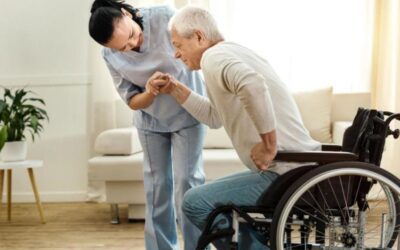Technological advancements in neurorehabilitation are constantly changing the therapeutic landscape and giving stroke survivors hope for a better future. One of these breakthroughs is Vibramoov, a ground-breaking treatment that redefines the limits of functional recovery for those with post-stroke deficits in their upper and lower limbs.
Vibramoov illuminates the neurorehabilitation pathways with a symphony of sensory experiences with the application of Functional Proprioceptive Stimulation (FPS). FPS simulates normal proprioceptive signals by creating a sense of movement in time with muscle extension, which is essential for the rehabilitation of the locomotor system. Vibramoov takes patients into a virtual world where their body and mind participate in a therapeutic dance, not only simulating but enhancing this experience.
The Vibramoov journey happens in phases, with each session characterised by a rise in patient participation and advancement. Vibramoov’s multifunctional approach allows for the regulation of muscular activity, pain relief, and the reactivation of latent muscles, among other therapeutic demands. Vibramoov, which can be modelled into four different therapy modes, provides a comprehensive rehabilitation roadmap for both patients and physicians.

Revival of the Vibramoov Movement
With precise targeting of important musculo-tendinous junctions, Functional Proprioceptive Stimulation (FPS) awakens muscle spindles. By igniting dormant neural connections, this neurosensory deception encourages the central nervous system to orchestrate motions that were previously considered to be impossible.
Pain Management:
Antalgy, in which individuals experiencing pain can find some relief via targeted stimulations. Vibramoov becomes a ray of hope among the agony by activating skin mechanoreceptors and triggering the gate control effect.
Controlling Muscle Tension:
Spasticity’s infamous enemy is taken on head-on by spasticity. Targeted stimulations bring antagonist muscles into balance, enabling more fluid and regulated motions. Mode 3 establishes mobility for those suffering from severe spasticity, setting the stage for next phases of rehabilitation.
Rebuilding Muscle Strength:
Tonicity is the starting point on the path to resilience and strength. Here, patients go off on a journey of transformation, experiencing the return of motor function, the rebuilding of lost mass, and the revival of muscle tone. Driven by proprioceptive engagement, this mode demonstrates the body’s amazing ability to regenerate itself.
Four modes of mobility from Vibramoov

First Mode: Mobility
The musculo-tendinous junction is treated with Functional Proprioceptive Stimulations (FPS). By mimicking the sensory cues of natural movements, FPS mechanically stimulates the neuromuscular spindles. Patients who receive this neurosensory stimulation are able to sense natural motions because it stimulates certain sensorimotor regions. Because the motor and sensory systems are intertwined, when a feeling is received, the CNS reacts by starting a motor response.
Conditions treated include ankylosis, adhesive capsulitis, CRPS, neurological impairment, and fractures and sprains.
Analgesia (MODE 2)
Through the activation of skin mechanoreceptors and the gate control effect, these focused stimulations are utilised to cure pain.
Adhesive capsulitis, tendinitis, neuralgia, sciatica and back pain, phantom pain, and neurological impairment are the conditions treated.
Mode 3: Spasticity
The middle muscle, which is opposed to the spastic muscle, is stimulated. They cause the antagonistic/spastic muscle to be reciprocally inhibited and the stimulated muscle to become more active. Before implementing mode 1 “mobility,” patients with severe spasticity should have numerous sessions of mode 3 treatment. State of Treatment: Stroke, BMI, spinal cord injury, and cerebral lesion-related brain damage
MODE 4: Harmony
Patients can: thanks to mode 4’s tailored interventions.Boost your muscular tone.
regain muscle mass
strengthen your motor skills
carry out significant proprioceptive tasks
When patients experience isometric contractions of the stimulated muscles in rhythm with the stimulations, the stimulations work at their best.
Neurological Damage, Sprain and Fracture, Balance Issue, and Muscle Weakness are the Conditions Treated
Beyond the walls of rehabilitation facilities, Vibramoov’s influence permeates lives with renewed possibilities. Vibramoov’s early and thorough treatments revitalise stagnated narratives by acting as a neuroplasticity trigger and giving each movement meaning and purpose.
Start your recovery journey with Vibramoov, the neurorehabilitation industry’s ray of hope. Visit www.rehabmodalities.com or send an email to info@rehabmodalities.com to receive a tailored road map for recovery. Let’s work together to unleash Vibramoov’s infinite potential and, one movement at a time, redefine the narrative surrounding stroke rehabilitation.



